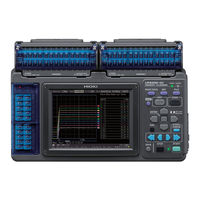Hioki LR8400-93 Power Verifier Manuals
Manuals and User Guides for Hioki LR8400-93 Power Verifier. We have 2 Hioki LR8400-93 Power Verifier manuals available for free PDF download: Instruction Manual
Hioki LR8400-93 Instruction Manual (300 pages)
Brand: Hioki
|
Category: Data Loggers
|
Size: 8 MB
Table of Contents
Advertisement
Hioki LR8400-93 Instruction Manual (4 pages)
PV Power Verifier
Brand: Hioki
|
Category: Measuring Instruments
|
Size: 0 MB

